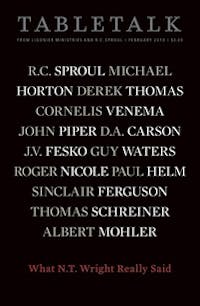
Request your free, three-month trial to Tabletalk magazine. You’ll receive the print issue monthly and gain immediate digital access to decades of archives. This trial is risk-free. No credit card required.
Try Tabletalk NowAlready receive Tabletalk magazine every month?
Verify your email address to gain unlimited access.
What I am doing [with the doctrine of justification], often enough, is exactly parallel, in terms of method, to what Martin Luther did . . . . I for one am proud to carry on that tradition — if need be, against those who have turned the Reformation itself into a tradition to be set up over scripture itself. —N.T. Wright, “The Shape of Justification”
The accusation that systematic theology (doctrinal formulations of the Reformation period in particular) overly governs (distorts) exegesis is not new, and Bishop N.T. Wright trots it out with renewed zeal in his latest book, Justification: God’s Plan and Paul’s Vision (SPCK, 2009). Thus, the Westminster Confession and the Thirty-Nine Articles were written in specific contexts, emerging
“from the titanic struggle to preach the gospel, to order the church, and to let both have their proper impact on the political and social world of the day. . . . When people in that situation are eager to make their point, they are likely to overstate it, just as we are today. Wise later readers will honor them, but not canonize them, by thinking through their statements afresh in the light of scripture itself” (p. 29).
And who could disagree with that? It all sounds so terribly reasonable and obvious. We all bring our own prejudices and worldviews to bear on the literature we read; indeed, in its more exaggerated form it leads to postmodernity’s skepticism of an exegesis of any text that is “true for all—for every individual at all times.” This is not Wright’s position. He is not abandoning the notion of truth claims—far from it! He simply wants to suggest that the truth claims of the sixteenth and seventeenth centuries were formulated with systematic/doctrinal concerns that shaped (mis-shaped) the exegesis of Scripture. Wright’s “critical-realist” approach suggests that we need to appreciate the “biblical worldview” at any given point in Scripture. Or, to put it in more Wright-like language: Can we identify the “stories” that shape and govern, for example, Paul’s understanding of reality, together with the “symbols” that define it?
A case in point is the doctrine of imputed righteousness, which he and others claim is nowhere explicitly found in Paul but which Reformed orthodoxy claims is vital in any formulation of redemption accomplished and applied. The “bias” forced upon exegesis by social, ecclesiastical, and political concerns of the time forces us, Wright insists, to ask,
“Why did they emphasize that point in that way? What were they anxious to safeguard, what were they eager to avoid, and why? What were they afraid of losing? What aspect of the church’s mission were they keen to take forward, and why? And, in particular: Which scriptures did they appeal to, and which ones did they seem to ignore? Which bits of the jigsaw did they accidentally-on-purpose knock onto the floor? In the passages they highlighted, did they introduce distortions? Were they paying attention to what the writers were actually talking about, and if not what difference did that make?” (p. 29).
The same questions must be asked of Wright’s exegetical method. What pre-considerations does he employ when getting at the meaning of a text? Wright will insist that to understand the New Testament, for example, we need to read it in its first-century context. Yes! And to do that we need to study first-century Judaism, archeology, and the Greco-Roman worldview for starters. Yes! Such findings—for example, the view that second-temple Judaism was essentially a works-righteousness religion—needs to be proved by careful study, something that the first volume of Justification and Variegated Nomism (ed. D.A. Carson, P.T. O’Brien, and M.A. Seifrid) does, though Wright says it doesn’t. And further, that means that lexicographical studies of the meaning of words—finding, for example, that substantial concurrences exist in the usage (and meaning) of words and phrases in the literature of the time must in some way reflect on how a word or phrase is employed in the New Testament. Yes, but not necessarily (the word agapē, for example is given an almost entirely new meaning in the New Testament), and John Piper’s strongly worded insistence that the usage of the word or phrase “right there in the Bible” must be given priority seems sensible and necessary as a controlling principle of interpretation (The Future of Justification: A Response to N.T. Wright, p. 36, n. 5).
Of course, it all sounds as though Bishop Wright is claiming that unlike his opponents, his methodology is “back to the Bible” and, more significantly, “back to Christ.” Unlike the prejudicial interpretation of the Reformers and those who adhere to them today, his view begins with a tabula rasa, a fair-minded, non-prejudicial view that reads Paul firmly within the setting of the time rather than through the (distorted) lens of sixteenth- and seventeenth-century squabbles. That this sounds too clean, too innocent is a judgment that we must make for ourselves and to which the rest of the articles in this month’s Tabletalk must seek to convince. The stakes are high, for within the crucible of these debates is not some peripheral issue of little or no importance but the very doctrine of salvation itself, the answer to the most basic question of all: How can a sinner be saved? We are being asked to believe that the church has misunderstood the most foundational issue of all—until, that is, along came a bishop who saw things clearly.
